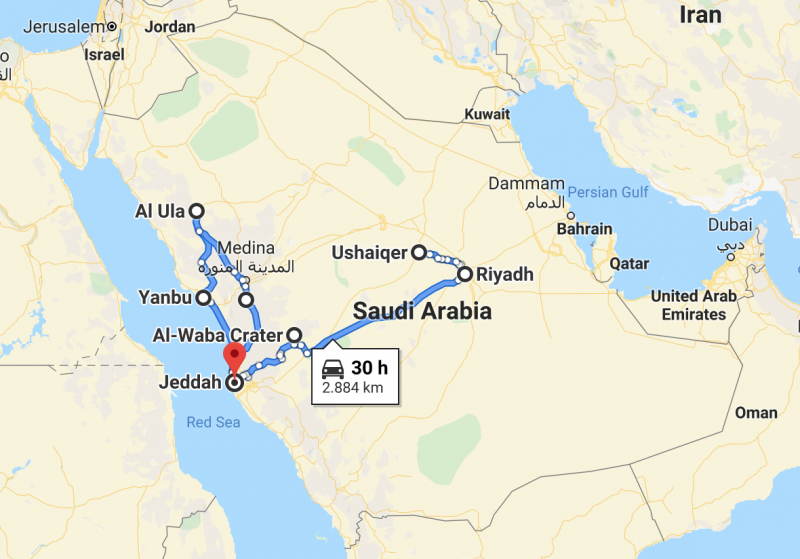Preparing for the Journey
Properly preparing your vehicle is essential for safely covering the long distance between Jeddah and Riyadh. The King Fahd Highway stretches over 900 kilometers through the heart of Saudi Arabia, so you’ll want to ensure your car is in peak condition.
Checking Vehicle Maintenance
Inspect key systems like the tires, braking system, fluids, belts, hoses, and battery for signs of wear. Top off fluids like motor oil, brake fluid, coolant and windshield washer. Also, check interior components like lights, wipers, air conditioning and communication devices. Replace or repair any parts that don’t seem to be functioning properly.

Packing Emergency Supplies
It’s a good idea to pack a well-stocked emergency kit in case unexpected issues arise along the route. Consider including a spare tire, jack, lug wrench, jumper cables, flares or reflective triangles, first aid kit, tool kit, blanket, water and non-perishable snacks. A working cell phone and car charger are also crucial for summoning roadside assistance if needed.
Fueling Up Before Departure
Consider filling up the gas tank before starting out to avoid running low between stations. Gas stations can be spaced fairly far apart, especially in remote stretches. Check that your fuel reserves will safely cover the full 900+ kilometer distance with some buffer left over for delays or detours.
Planning for Comfort and Safety
Taking regular breaks is important for long road trips to avoid drowsiness and fatigue setting in. Proper planning will help you stop safely and refresh comfortably.
Scheduling Rest Stop Locations
Research populated areas and major exits along the route that offer accessible rest stop amenities. Plan to stop every two to three hours to stretch, use restrooms, grab a snack and check maps/directions. Popular options include service stations, towns, roadside restaurants and truck stops.
Packing Necessities for Breaks
Bring drinks, snacks, music or podcasts for entertainment on stops. Also pack cleaning supplies, hand sanitizer and toiletries. Ladies should consider an emergency hygiene kit. Dress in layers and pack a lightweight jacket in case temperatures vary between day and night travel.
Designating a Navigator
On multi-person trips, designate a navigator to handle directions, mileage estimates and suggesting break times. This allows the driver to focus solely on the road. Navigators can also help watch for traffic conditions, road signs or emergency vehicles up ahead.
Considering Conditions and Safety Risks
Road conditions, driving habits and environmental factors all influence safety on the long trip between cities. Awareness and planning can help mitigate risks.
Checking Weather and Road Reports
Monitor weather forecasts and check for notices about road construction zones before departure. Pay attention to warnings about blowing sand, fog or high winds that could affect visibility or traction. Some stretches may experience flash flooding during rain.
Practicing Defensive Driving Skills
Drive cautiously and obey all traffic laws. Maintain safe following distances between vehicles in case you need to brake suddenly. Use turn signals well in advance and scan mirrors frequently for position awareness. Never drive while fatigued or under influence of substances.
Avoiding Night Travel If Possible
Night driving greatly increases risks like missing road signs, wildlife encounters or faulty perceptions in darkness. Consider stopping near your destination for daylight travel if a long stretch will take you into nightfall. Adjust driving patterns if traveling after dusk.
Consulting Maps and Guidance Systems
Relying only on one navigation method can lead you astray, so diversifying aids can provide reassuring backups.
Downloading Digital Maps
Save offline map data for the entire route in the event of spotty cell service. GPS apps need internet to provide real-time rerouting, but static maps still show major roads and landmarks.
Printing Paper Road Maps Too
Laminated or sealed paper maps withstand weather and don’t rely on batteries or connectivity. They provide a physical backup in case electronics fail completely. Stash maps in both vehicles if traveling in a convoy.
Programming Multiple Checkpoints
Use GPS to input checkpoints at major exits, intersections and incorporated cities as confirmation points. Navigate incrementally to avoid missing turns if gps signal cuts out temporarily.
Consulting Online Trip Reviews/Forums
Research route details shared by other motorists online to uncover any little-known hazards, dangers spots or detour alternatives to watch for en route. Their experiences raise situational awareness.

 Living in Luzhou - A Local's Insight into the City
Living in Luzhou - A Local's Insight into the City